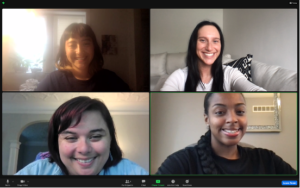For our third challenge of the 2021-2022 program year, we were excited to partner with Brilliant Detroit, a nonprofit dedicated to building kid success families and neighborhoods where families with children 0-8 have what they need to be school ready, healthy and stable. Eight teams of Fellows worked collaboratively with Brilliant Detroit staff and community stakeholders to deliver this project – learn more from the perspective of each team!
Design Thinking Tips: Must-Read Advice for Beginners
If you need design thinking tips for everything from the design thinking question, when to know to pivot, and whose voices really matter, we’ve got you covered in this feature.
Our design thinking question: “How might we communicate key dashboard findings to external stakeholders?”
Design Thinking Tip 1: If It Sounds Too Good To be True, It Probably Is
Challenge Partner kick off days mean learning who your teammates are, the partner’s mission, and what your team is responsible for bringing to life. This could look like one of two things: a design thinking question that holds space for ambiguity or one that is relatively straight forward. From our experience, if it sounds too good to be true, it probably is, and here’s why. Viewing the design thinking question as a straightforward task might limit the creative process and, in most cases, these types of design thinking questions tend to be the most challenging to create. Be prepared to take on the challenge.
Design Thinking Tip 2: Know When To Pivot
There comes a time during the stages of design thinking when teams meet with partner liaisons to ask questions and learn if they are on the right track. Sometimes the feedback can send a confident team spiraling into confusion. Did we just waste an entire ideation session?
It’s important to know when to pivot. Time is of the essence. Here’s how our team tackled challenge 3. We started creating a general communications toolkit showcasing the findings of the dashboard. Then our partner liaison asked us to pivot, suggesting that we first teach external stakeholders what the dashboard is and how to use it. Instead of starting from scratch we decided to build on our original ideas and ideated on: How might we help neighbors, policy makers, partners, and families understand the dashboard? We recommend listening intently to liaisons but also making sure to keep close to your design thinking question.
Design Thinking Tip 3: Everyone’s Voice Matters
Our team reflected on the last several Fridays of design-thinking and identified one of the greatest tips this project has taught us. Everyone’s voice matters.
It’s true that empathy is embedded into our DNA once we become a CD fellow, but we feel compelled to share why. We listen to our partner’s stakeholders, and we hear pain points. Sometimes, we even hear stories that send chills down our arms. During the design thinking process, sometimes we struggle with learning each other’s social styles and other times we misinterpret each other. But when we make a safe space to openly share thoughts, feelings, and ideas we create an inclusive environment. This is where our BRILLIANT ideas soar.
After we listened to all those important voices, our team recommended a neighborhood dashboard launch party with reading hopscotch and wearable statistics for the kids to be proud of their accomplishments. Our team was dedicated and iterative during this project and it’s because we know every voice matters. If these 3 tips are taken into consideration, then your creative process should be just as rewarding.

***

